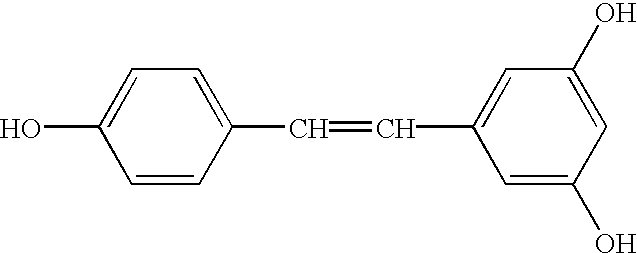Transgenic legume plants modified to produce resveratrol glucoside and uses thereof
a technology of resveratrol glucoside and legumes, which is applied in the field of transgenic plants and plant cells, can solve the problems of reduced seed yield, reduced flower color, and plant damage, and achieve the effect of increasing the level of resveratrol glucoside and decreasing the spoilage of edible plants
- Summary
- Abstract
- Description
- Claims
- Application Information
AI Technical Summary
Benefits of technology
Problems solved by technology
Method used
Image
Examples
example 1
Transformation of Alfalfa with Peanut RS CDNA
[0066]Alfalfa was transformed using a peanut RS cDNA, and the resulting transgenic plants were investigated.
Plant Material and Greenhouse Conditions
[0067]Alfalfa (Medicago saliva L.) c.v. Regen SY (Bingham, et al. 1991 “Regeneration of alfalfa hybrid Regen-Sy germplasm from tissue culture and transformation research,”Crop Sci 31:1098) stocks and transgenic lines were maintained in greenhouse conditions under a 16 hour photoperiod in MetroMix 350 (The Scotts Co., Marysville, Ohio). Independent transgenic lines were vegetatively propagated by cuttings, planted in MetroMix 350 in growth chambers (Conviron, Winnipeg, Manitoba, Canada) under a 16 hour photoperiod with 100% relative humidity for 3 weeks.
Vector Constructs and Plant Transformation
[0068]The peanut (Arachis hypogaea) resveratrol synthase (RS) CDNA (nucleotides 902 to 2854 of SEQ ID NO:1 and FIGS. 1A and 1B) (Tropf, et al. 1994. “Evidence that stilbene synthases have developed from ...
example 2
Agrobactenum-mediated Transformation of Soybean
[0087]In soybean, the CaMV-35S:RS binary construct or the pGA482 binary vector control plasmid was introduced into Agrobacterium rhizogenes Strain K599 (Savka, et al. 1990. Phytopathology 80:503-508) using a standard freeze-thaw technique. A. rhizogenes colonies containing the binary vector were selected on YMB agar plates with kanamycin (25 mg / l) and tetracycline (12 mg / l). The composition of the YMB agar plates per liter was 0.45 grams anhydrous dibasic potassium phosphate, 0.2 grams magnesium sulfate (7H2O), 0.1 g sodium chloride, 10 g mannitol, and 0.4 g yeast extract. Components were dissolved in distilled water, the pH adjusted to 6.5, 15 g of bacteriological grade agar (Bactoagar, Gibco, Rockville, Md.) was added, and the mixture was sterilized by autoclaving for thirty minutes at 121° C. After cooling to approximately 50° C., the appropriate antibiotics were added and poured into sterile plastic petri plates. Selected colonies w...
example 3
RGluc-produciug Transgenic Alfalfa Diet for Mouse
[0094]Because alfalfa is a highly nutritious animal feed, a study was carried out to compare the chemopreventative activity of a basal diet and a diet supplement with dried transgenic RGluc accumulating alfalfa.
[0095]The transgenic alfalfa was dried for 24-48 hours in a convection oven, powdered in a cyclone grinding mill to a particle size of less than one millimeter, and then blended at a rate of 20% weight / weight into the basic diet, which was then formed into food pellets. Four replicate samples of the dried powdered alfalfa was extracted with 90% acetone / 10% water for a 24 hour period. The extract was taken to dryness and resuspended in methanol and subjected to HPLC analysis for RGluc. The powdered alfalfa contained 162 micrograms RGluc (equivalent on a molar basis to approximately 95 micrograms resveratrol).
[0096]The assay used was the mouse aberrant crypt foci (ACF) system (Olivo, S. and Wargovich, M. J. 1998. “Inhibition of a...
PUM
| Property | Measurement | Unit |
|---|---|---|
| pH | aaaaa | aaaaa |
| volume | aaaaa | aaaaa |
| flow rate | aaaaa | aaaaa |
Abstract
Description
Claims
Application Information
 Login to View More
Login to View More - R&D
- Intellectual Property
- Life Sciences
- Materials
- Tech Scout
- Unparalleled Data Quality
- Higher Quality Content
- 60% Fewer Hallucinations
Browse by: Latest US Patents, China's latest patents, Technical Efficacy Thesaurus, Application Domain, Technology Topic, Popular Technical Reports.
© 2025 PatSnap. All rights reserved.Legal|Privacy policy|Modern Slavery Act Transparency Statement|Sitemap|About US| Contact US: help@patsnap.com



